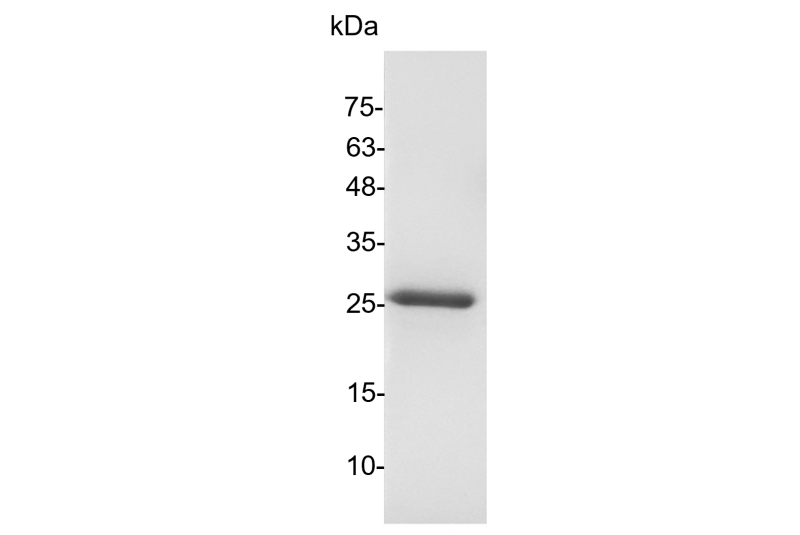SUMO-Specific Protease 2 (SENP2)
SENP2 is an enzyme that belongs to the protease family C48. Structurally, SENP2 harbors the C48 catalytic domain which is typically located close to the C terminus and has been reported to engage two SUMO pathways. The first is cleavage processing of small ubiquitin-like modifiers (SUMO1, SUMO2, and SUMO3) propeptides, subsequently leading to protein maturation. The second is the cleavage processing of SUMO1, SUMO2, and SUMO3 from targeted proteins. SENP2 protease has a His-tag for easy removal from a cleavage reaction by using nickel affinity resins.
Source:
Escherichia coli
Endotoxin Test:
<1 EU per 1 μg of the protein by the LAL method.
Purity:
>95% as determined by SDS-PAGE analysis.
Form:
Storage Buffer:
55mM Tris-HCl, 165 mM NaCl, pH7.5.
Stability & Storage:
This product is stable after storage at:
• -20°C or -80°C long-term storage under sterile conditions.
Avoid repeated freeze/thaw cycles.
Shipping Conditions:
Dry ice
Escherichia coli
Endotoxin Test:
<1 EU per 1 μg of the protein by the LAL method.
Purity:
>95% as determined by SDS-PAGE analysis.
Form:
Liquid
Storage Buffer:
55mM Tris-HCl, 165 mM NaCl, pH7.5.
Stability & Storage:
This product is stable after storage at:
• -20°C or -80°C long-term storage under sterile conditions.
Avoid repeated freeze/thaw cycles.
Shipping Conditions:
Dry ice
1. To optimize cleavage conditions, it is recommended to run preliminary cleavage reactions at a small scale.
2. Dilute the target protein sample to 1-2 mg/mL with PBS solution.
3. An effective general range of the SENP2 protease: target protein ratio is 1 μg :50 μg.
4. Reaction can be performed at 4°C-37°C. 4°C is recommended as the starting standard. Incubate the reaction mixture at 4°C for 16 hours or overnight.
5. Determine cleavage level of the samples by SDS-PAGE analysis.
6. Once optimize for the cleavage condition, the cleavage reactions can be scaled up to cleave a large amount of the target fusion protein.
‧ SENP2 protease: target protein ratio of 1 μg :50 μg is used for most fusion protein cleavage. Cleavage efficiency may differ based on structure and properties of each target protein, we recommend testing several enzyme-to-substrate ratios, temperatures, and incubation times.
‧ We recommend performing longer cleavage time at lower temperatures (4°C) for cleavage efficiency.
.png)
SDS-PAGE analysis of substrate digested with SUMO-Specific Protease 2 (SENP2) in different ratio.
Lane1: substrate only, Lane2: 1:25, Lane3: 1:50, Lane4: 1:100
2. Dilute the target protein sample to 1-2 mg/mL with PBS solution.
3. An effective general range of the SENP2 protease: target protein ratio is 1 μg :50 μg.
4. Reaction can be performed at 4°C-37°C. 4°C is recommended as the starting standard. Incubate the reaction mixture at 4°C for 16 hours or overnight.
5. Determine cleavage level of the samples by SDS-PAGE analysis.
6. Once optimize for the cleavage condition, the cleavage reactions can be scaled up to cleave a large amount of the target fusion protein.
‧ SENP2 protease: target protein ratio of 1 μg :50 μg is used for most fusion protein cleavage. Cleavage efficiency may differ based on structure and properties of each target protein, we recommend testing several enzyme-to-substrate ratios, temperatures, and incubation times.
‧ We recommend performing longer cleavage time at lower temperatures (4°C) for cleavage efficiency.
.png)
SDS-PAGE analysis of substrate digested with SUMO-Specific Protease 2 (SENP2) in different ratio.
Lane1: substrate only, Lane2: 1:25, Lane3: 1:50, Lane4: 1:100


